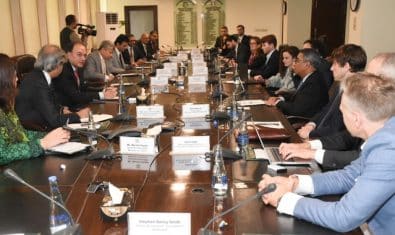World Bank in its 2022 Country Climate and Development Report (CCDR) for Pakistan recommended gradually phasing down and repurposing agriculture subsidies on wheat support, fertilizer production and distribution, and electricity tube wells towards agriculture research, rural development, and building climate resilience.
The government allocated Rs. 16.5 billion between 2019-20 to 2023-24 to increase wheat productivity at the national level while the federal government also spent Rs. 2.94 billion for wheat subsidy in 2022-23 excluding the billions spent on procurement and storage operations while Punjab’s commodity debt is expected to touch Rs. 950 billion by the end of the fiscal year.
The government also handed out Rs. 70.4 billion between 2018-22 to LNG-based urea production plants operated by Fatima Fertilizer and Agritech Limited while Rs. 30 billion were spent in the current fiscal year alone to subsidize imported urea.
But wheat productivity has largely been stagnant and at the mercy of climatic variables decreasing by 2.5 percent last year due to heatwaves and experiencing a 4.5 percent increase this year given the moderate weather and water stored in soils from last year’s floods. The price of urea has also gone up from Rs. 1,500 in 2018 to Rs. 2,565 in 2023 despite the billions in subsidies.
World Bank stated that these subsidies are inefficient and provided little gain to small landholders as their majority production is for subsistence while putting a strain on fiscal resources and discouraging crop diversification. It also stated that wheat procurement only benefits large landholders, millers, and commercial banks.
It also argued that resources should be directed towards increasing productivity through means other than extensive input use and embracing more diverse and nutritious diets with more vegetables and fruits.
We do not recommend dropping wheat production in favor of other crops of course, but to modernize the overall wheat value chain to make Pakistan more competitive on wheat and reduce the fiscal burden the current system generates, while, at the same time. stimulating crop and livestock diversification” clarified World Bank Spokesperson Mariam Sara Altaf talking exclusively with ProPakistani.
But she added that the current wheat support program does not deliver in terms of productivity gain and affordable food and public resources spent on wheat subsidies could be gradually repurposed to improve agronomic research, climate resilience, and infrastructure development and better directed towards small farmers.
Talking about the subsidies to the fertilizer sector she said “It is the perfect example of how untargeted public support could be replaced by more targeted assistance to smallholder farmers”.
She pointed out that it will incentivize medium and large farmers to diversify into higher-value crops by reducing their economic advantage due to the distorted wheat subsidy policy, but she also stressed that any policy shift in fertilizer subsidies will be needed to be coupled with social protection measures and better-targeted support i.e. fertilizer vouchers to avoid shocks and ensure house-holds self-sufficiency.
While it all sounds well and good, Pakistan has been a net wheat importer since 2013 and the majority of the farmers who you ask about why they cultivated wheat last year will answer that because of the support price increase. Pakistan adds 4.4 million souls yearly to its population and abolishing wheat support will dearly threaten the national food security.
Secondly, domestic urea prices are still less than half of the international market because of the availability of cheaper gas. Most of these plants will not be feasible to run without cheaper gas and unless we believe our farmers can afford a urea bag sold at Rs. 6000-7000, simply abolishing subsidies is not an option.
Wheat subsidies secure national food security and are critical to support small and medium landholders and an abrupt withdrawal can financially kill the farming communities”, stated Aamer Hayat Bhandara co-founder of Think Tank Agriculture Republic.
He said that while he is personally against the subsidies, farmers’ productivity is too low and this support is the closest thing farmers have to financial and social security, but he agreed that the subsidies should not be provided if the farmer productivity is comparable with other countries in the region.
He also added that the money that goes to farmers circulates into the economy instead of sticking in real estate which happens in the case of other industries. Talking about urea subsidies, he said that the fertilizer sector should be deregulated as it is rarely sold at the notified rate anyway.
Climate change knocked out cotton and rice production by 41 percent and 21.5 percent in 2022-23 with devastating floods. Heatwaves declined mango production by 50 percent last year while cooler temperatures are projected to decrease its production by 20 percent this year. Studies predict a future decline of 19 percent and 26 percent in maize and rice production respectively, so it’s pretty understandable to shift more money into climate-smart technologies.
World Bank provided Pakistan with $200 million for the development of Climate Smart Agriculture (CSA) but sustainable and visible change is a fantasy without the increased participation from the private sector. Pakistan needs far more investments in early-warning weather systems and R&D for climate-resilient cultivars.
“There is an urgent need to redirect public spending from inefficient subsidies and price support towards investments in agriculture research and extension to help farmers adopt climate-smart practices,” added Mariam Sara Altaf from the World Bank.
She also highlighted the need for a progressive reduction of distortive market interventions to attract private investments especially Supporting wheat sector reforms that limit the need for the state to excessively borrow to finance its commodity procurement may reduce its effect of crowding out private credit.
Current subsidy regimes are inequitable due to structural inefficiency that stems from the crooked status quo which is prevalent, especially in Southern Punjab and Interior Sindh. Any initiative, with all of its benefits, is a ruse without raising social awareness and educational standards in the rural populace.
Reforms cannot possibly be enacted meaningfully without the help of people benefiting the status quo (good luck getting that) and not many people from the bottom can enter decision-making circles without these reforms, a classic chicken-and-egg problem.
“Agri-food sector transformation and sustainable change are reliant on raising social awareness and grassroots empowerment” agreed Mariam adding that there is a need for wide stakeholder consultations, especially with farmers, landowners, professional organizations, and the private sector, to forge a consensus to revisit the public support program.
She added that Farmer groups, water users associations, and community support organizations are critical to bring about demand-driven local economic development all World Bank’s projects include interventions to support such groups for capacity building, coordination on on-farm irrigation issues, and access to resources for community-managed infrastructure improvement.
She also revealed that their team is finalizing a report on Rural Transformation in Pakistan which talks extensively about the role of community-driven development and local governance in rural transformation.
The despicable state of living standards prevalent in remote areas of Punjab and Sindh can only be found in stories as mostly when media pay them to visit they are either underwater during floods or under droughts and diseases and those stories have become so frequent and redundant that even audience switch the channels.
“The better path towards rural development is to enable crops-related SMEs near villages which will provide job opportunities, generate a skilled workforce, and will also fix the supply chain losses and the transportation costs to farmers”, added Aamer Hayat Bhandara.
If Government can achieve something like this, it can not only eliminate the middlemen and significantly boost the farmers’ economic benefits but can also stem the tide of people pouring into urban centers for opportunities that are already mismanaged and overcrowded.
The sustainable way of getting rid of the financial burden from subsidies is to bring down the cost of production, increase productivity and come up with something better than the Kisaan card to target small landholders otherwise we will be providing the same subsidies ten years from now with similar or worse results in the face of far more population.
While it is true that building a climate resilient agriculture needs investment, it does not necessarily have to come from the government. The industries that rely on the production of certain crops need to step up their support to farmers and also establish a climate support program which should also be funded by the money saved by privatizing the wheat market and removing subsidies for large landholders.
Climate change is a rare opportunity to bring the dysfunctional agriculture sector together as it threatens everyone the same from farmers, manufacturers, exporters, and the government, and fixing the aimless public spending and reprogramming the subsidy regime will only be the start of it.






















